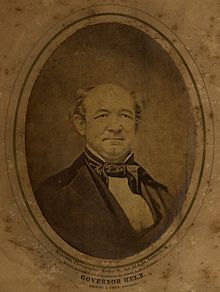John LaRue Helm
| John L. Helm | |
|---|---|

John L. Helm photographed by Klauber, Louisville, Kentucky, undated.
|
|
| 18th & 24th Governor of Kentucky | |
|
In office September 3, 1867 – September 8, 1867 |
|
| Lieutenant | John W. Stevenson |
| Preceded by | Thomas E. Bramlette |
| Succeeded by | John W. Stevenson |
|
In office July 31, 1850 – September 2, 1851 |
|
| Preceded by | John J. Crittenden |
| Succeeded by | Lazarus W. Powell |
| 13th Lieutenant Governor of Kentucky | |
|
In office September 6, 1848 – July 31, 1850 |
|
| Governor | John J. Crittenden |
| Preceded by | Archibald Dixon |
| Succeeded by | John Burton Thompson |
| Member of the Kentucky Senate | |
|
In office 1844 |
|
| Member of the Kentucky House of Representatives | |
|
In office 1826–1843 |
|
| Personal details | |
| Born |
July 4, 1802 Hardin County, Kentucky |
| Died | September 8, 1867 (aged 65) Elizabethtown, Kentucky |
| Political party |
Democrat Whig |
| Spouse(s) | Lucinda Barbour (Hardin) Helm |
| Relations | Son-in-law of Benjamin Hardin Father of Benjamin Hardin Helm and Lucinda Barbour Helm |
| Residence | Helm Place |
| Profession | Lawyer |
| Signature | |
John LaRue Helm (July 4, 1802 – September 8, 1867) was the 18th and 24th governor of the U.S. state of Kentucky, although his service in that office totaled less than fourteen months. He also represented Hardin County in both houses of the Kentucky General Assembly and was chosen to be the Speaker of the Kentucky House of Representatives four times. In 1838 his sole bid for federal office ended in defeat when his opponent, Willis Green, was elected to the U.S. House of Representatives.
Helm was first elected to the Kentucky House of Representatives in 1826; between 1826 and 1843 he served eleven one-year terms in the state house. In 1844 he was elected to the state senate, where he served continuously until he was chosen as the Whig Party nominee for lieutenant governor on a ticket with John J. Crittenden, famous for the Crittenden Compromise. The Whigs won the general election and Helm was elevated to governor on July 31, 1850, when Crittenden resigned to accept an appointment as United States Attorney General in President Millard Fillmore's cabinet. After his service as governor Helm became president of the struggling Louisville and Nashville Railroad. He invested thousands of dollars of his own money in the project and convinced residents along the line's main route to buy stock in the company. In 1859 the line was completed, but the next year Helm resigned over of differences with the board of directors regarding a proposed branch that would extend the line to Memphis, Tennessee.
...
Wikipedia
